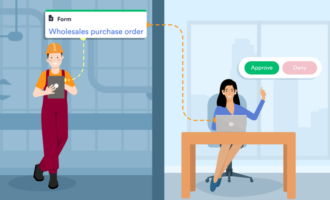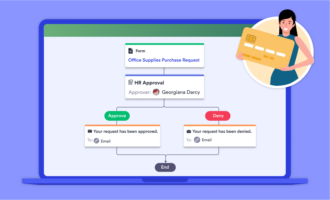Every business starts with an idea. Typically, an individual or a group of people will identify a need, come up with a solution or product that didn’t exist before, and put a plan into action to make the idea a reality. The scale of this process can sometimes be overwhelming, which is why most people prefer to keep it as simple and efficient as possible.
Whether you’re just starting out as a new business or implementing a new product line, you’re going to need supplies to reach your goals. Securing these goods is known as procurement, the process businesses follow to obtain what they need to maintain operations or make products.
Business owners must establish set procurement workflows. These workflows identify what supplies and materials are needed and how to get them. Creating the right procurement structure — with accompanying documentation and automation — helps your company optimize its transactions.
That’s where the purchase order process comes in. By following the steps in the process, business owners can create a streamlined method for procuring the goods and services they need. Here’s your guide to what you need to know about the purchase order process and the steps to follow for proper procurement.
Planning
Part of the purchase order process involves completing the necessary tasks that lead up to a purchase order. That means deliberating internally about why you need certain items, determining exactly what you need, and then communicating that request through the proper channels.
Once you’ve done this background work, a purchase requisition is helpful. This internal document ensures you have organizational approval to devote resources and money to procure something. Employees and managers send requisitions to higher-ups to begin discussing what needs to be purchased.
For the purchase order process to work effectively, you and your employees have to be on the same page about what you want and which vendors you’ll buy from. That’s what a purchase requisition provides.
By passing the requisition through organizational channels, the people with decision-making power can manage where and how company money is spent. What’s more, a requisition prepares everyone for the purchase order process, so employees can present a united front when reaching out to a supplier for goods or services.
Preparing a purchase order
Once you’ve approved the goods, prices, and vendors with a purchase requisition, you can begin the purchase order process. When creating a purchase order, it’s important to understand the different components to include. In addition to purchase requisition line items like quantity of goods and cost, the purchase order also contains contact information for the buyer and seller, as well as the delivery date and shipping terms.
If you have the right information in the requisition, this step in the purchase order process should run smoothly. The goal here is to come to an agreement with a supplier. Once a seller signs a purchase order, it becomes a binding agreement, representing a legal requirement to pay for and provide the goods or services specified.
After a seller approves a purchase order, the supplier sends a sales order. This document serves as an order confirmation or receipt, stating that the supplier will deliver goods at an agreed-upon time and price.
Evaluating the purchase order process
Completing a purchase order is more than a one-and-done procedure. Each time you fill out this document, you’re committing to spending company money — something no one should take lightly.
Still, purchasing can be a fluid process — the context in which your business operates and its available resources are going to change. That means orders for identical items aren’t necessarily going to be the same each time you purchase them.
You need to consider how factors like time of year, consumer demand, and your company’s production capabilities affect what and how much you order. A purchase order isn’t just an itemized list — it’s a way to look at how your business operates and identify opportunities to fill in any gaps.
For example, in the middle of the summer, a movie theater might need to place a larger order for popcorn kernels than it would in the winter. The theater might consider placing recurring weekly purchase orders instead of ordering every other week. During this process, it would receive corresponding orders from its vendors that it could use to chart its order volume requirements during different times of the year. This information, in turn, would allow the theater to budget for the following year.
When you receive orders from a vendor, you can compare and contrast costs to adjust your budgets and create more efficient strategies in the purchase order process. This closed loop helps you maintain detailed records to reference and analyze. With these records, you can change your ordering practices accordingly and operate as effectively as possible.
Creating a database
Your company will need different types of supplies to operate at peak efficiency. That’s why creating a purchase requisition, to review internally, and a purchase order, to send externally, is so important. By using best practices for these different approval workflows, you can make your purchasing more efficient.
For example, if you’re overspending on a specific product, you can reevaluate and either order a lower quantity or find a different vendor to get a better offer. Keeping proper records allows you to pull data, draw conclusions about your spending habits, and decide whether your purchases are translating into overall growth.
Even better, the more you do business with a vendor or supplier, the more you can keep everything moving smoothly, as documentation provides the clarity needed for a good business relationship. A purchase order to a supplier you’ve been doing business with for months will have a lot less red tape than one for a vendor you’re reaching out to for the first time.
Establishing these relationships — and having previous documentation to look back on to fulfill recurring or bulk orders — can foster stronger relationships and reduce errors when it comes time for goods to be delivered.
Automating with Jotform
Given the number of transactions your company carries out in the course of business, you need an all-in-one platform to store past and present orders. A manual purchase order process would be tedious and take too much time.
With Jotform, you can automate your workflow and create a repository to store your purchase order information. Jotform’s purchase order form templates have all the necessary components you need to send to a vendor.
If you have account leads who work with specific clients or purchase categories, you can use Jotform’s Assign Forms feature to designate specific tasks to that individual or team. This feature makes it clear who’s responsible for completing a given assignment.
You can also level up automation with Jotform Approvals, which facilitates approval workflow-building. Its drag-and-drop interface allows you to customize the workflow to your needs, creating an extra layer of transparency by laying out in detail exactly what you’re doing, how you’re doing it, and which managers are in charge of approvals.
It takes minutes to set up an approval flow in Jotform Approvals. And the approval functionality is complemented by tools like Jotform Inbox. With a centralized location to send messages, respondents can receive notifications about whether their requests have been approved, as well as who has submitted forms. Another tool, Jotform Tables, allows managers to arrange purchasing data, view form submissions, and create reports.
Ordering from start to finish
The purchase order process might seem simple at first, but it has many layers. Think about it as the backbone of your business. Without proper supplies, it’s impossible to operate — whether you need new computers or materials to create a new product.
Instituting the proper measures and policies, and designing the right steps to receive the items you need, is the only way your business can achieve its goals. That means creating a purchase requisition to set up the purchase order process and analyzing your ordering practices as your business grows, changes, and becomes more efficient. Platforms like Jotform can house your purchase order information and support your growing procurement needs.
As your business grows, so will the amount of inventory and supplies you consistently need. That’s why having the right infrastructure and methods in place to chart this growth and manage your procurement is vital.
The most successful businesses are the ones willing to adjust when they encounter disruptions in their workflow, so they stay organized. When it comes time to approach a supplier — or adjust the way you process orders — carrying out the necessary steps will be a piece of cake.
















Send Comment: